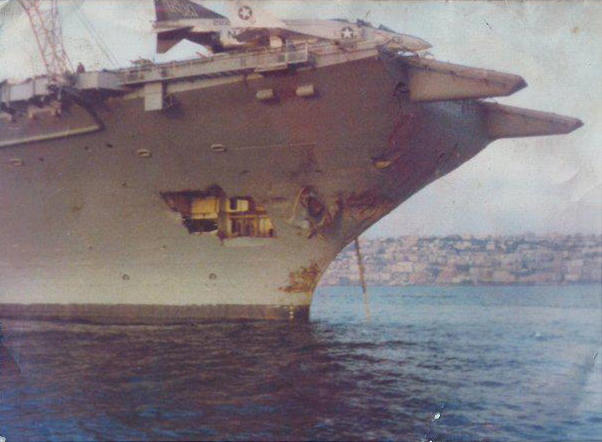See the mishap pages in the main menu (above) to read some more interesting stories. We welcome your contributions to this section. There are many stories yet untold told that will be lost if not preserved. If you have a story please click here to contact me.
1948 – F6F-5N Hellcat:
This is a video of a F6F-5N Hellcat making an emergency landing with an engine fire – (Donated by Gary Schreffler).
1950 – AJ Savage crash:
A short PLAT video from 1950 of an AJ-1 Savage going over the bow after a deck run – (Donated by Gary Schreffler).
Aircraft: AJ-1 Savage
Date: 27 October 1950
Squadron: VC-5
BuNo: 124163
Crew: The Plane Commander was LCDR Dave Purdon, the B/N was LTJG Ed Decker, and the Third Crewman was Chief Edward R. Barrett.
Known details: The aircraft crashed into the sea on its takeoff run from USS Franklin D. Roosevelt. LCDR Dave Purdon Dave and the crewman, Chief Edward R. Barrett, were lost, but B/N LTJG Ed Decker escaped from the wreckage with minor injuries and was rescued by the plane guard helicopter. Analysis of witness statements and movie and still photos failed to positively identify the cause of the accident, but the most likely cause was determined to have been an inadvertent engagement of the flight control gust lock. [Mishap details from http://skaneateles.org/navy/aj_accidents.html]
Follow-up: The following are emails exchanged between two pilots that were aboard FDR in 1950 [Porter Smith & Bill Greenwood]:
I was on the bridge as JOOD the morning of the TWO crashes of the AJs. We were all standing there stunned at what had just happened when we heard another plane coming down the deck. It was the 2nd AJ. He knew he was going to crash so he banked hard to port and cleared the ship. I don’t know how many, if any crew survived. We took the 3rd one back to Malta and dropped it on the dock.
What has always puzzled me was why the navy did not mark out the carrier deck on a runway to see if this ½ jet- ½ prop job had enough power to get airborne in a deck length; which it obviously did not have. So ended the Navy’s effort with this plane on carriers.
Vaguely remember this take off. However, do remember the AJ1’s real well. Remember the early trials off of Gitmo of the top secret project, etc. and going ashore in Cuba and seeing headlines in the local paper, “nuclear bomber crashes off carrier.”
It might have been the Malta time when they came aboard and I got friendly with the CO and he asked me to go on a flight with them the next morning. I hesitated, citing all the accidents I had seen with them. He said that had all been cleared up now and I could ride in the navigators seat as he was the first one off. I promised to meet him at the ready room the next AM. Something made me back out overnight and I met and said no to the ride. I remember going up in the superstructure to watch the first plane off on the starboard catapult and seeing it plunge in and looking over the side as we went by and seeing helmets bob up to the surface, thinking that there, but for the grace of God, could have been me.
Atlantic 05/15/57:
The USS Franklin D. Roosevelt (CVA-42) reportedly hits a submerged object off Florida. The object is not thought to be a submarine. The Navy later denies that the carrier had hit an object, claiming instead that a propeller had broken.
Atlantic 06/19/57:
A high-pressure steam line explodes aboard the USS Franklin D.Roosevelt (CVA-42) off Jacksonville, Florida, killing two and injuring five. Account and diagram here.
Atlantic 10/04/59:
The USS Franklin D. Roosevelt (CVA-42) collides with the USS Pawcatuck (AO-108) during refueling off Virginia. Both vessels are slightly damaged.
Mediterranean 06/03/60:
F8U plane crash filmed by Lou Cera PH3 (Aft photo station) & Warren Hoey PH3 (06 level).
Caribbean 10/21/61 Ejection – Video, Pictures and Story:
A short PLAT video from 1961 of an F-8 hard landing and ejection.
The photos were taken by PH3 Louis J. Cera, who explains: “[I used] an 8-mm movie camera & a K-20 aerial camera combo made up by our camera repair Chief, C.A. White, PHC. Cameras were rigged with each other, with their own activator buttons, or both could be run at the same time by holding down both buttons. I was stationed on the 06 level and my job was to anticipate any and all possible aircraft crashes.”
Setting the stage:
This incident occurred on the FDR in 1961 south of the Dominican Republic. The aircraft was an F8U-1 assigned to VF-11, the Red Rippers, piloted by Ltjg. Terry Kryway.
Ripper Jim Roberts: I recall it clearly, having flown that same day. The sea state was really crappy and when Terry made his landing I was in the ready room watching his landing on the PLAT. It could have happened to ANY of us flying the Crusader aboard the Roosevelt that day. The deck was moving all over the place, and with only a 12 foot hook-to-ramp clearance, there was NO room for error coming aboard. Thus, but for the grace of God, any of us could have taken the same ride. …….. I think it should also be pointed out – – emphasized – – that Terry was a super outstanding pilot. He was a member of the Red Rippers flight demo team, and that single event should not, in any way, detract from our view of his piloting ability.
—————-
USN photos & blow-by-blow commentary courtesy of Ripper Swede Hedberg (Swede observed the incident from PriFly).
….. the aircraft hit hard on the stbd main mount and broke off the wheel. The wheel bounced up into the wheel well and ruptured the main fuel line; that’s the cloud of fuel you see in the first picture.
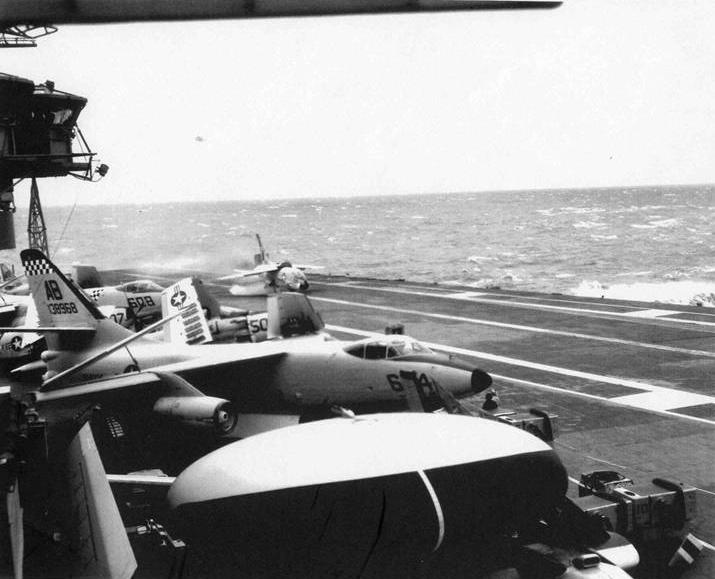
The scraping of the bare main strut pulled the nose to the right, imposing an asymmetrical load on the tailhook, ripping it out (movies from the starboard quarter showed this). The fuel caught fire, and the rest is as you see it.

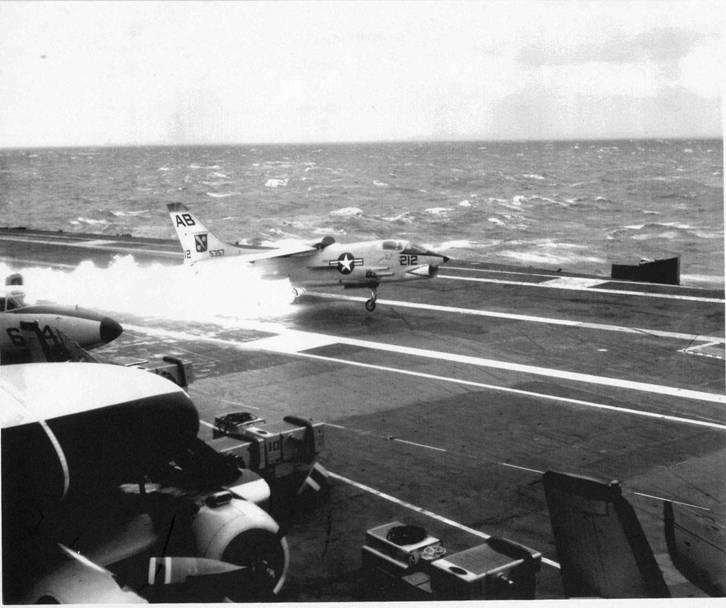
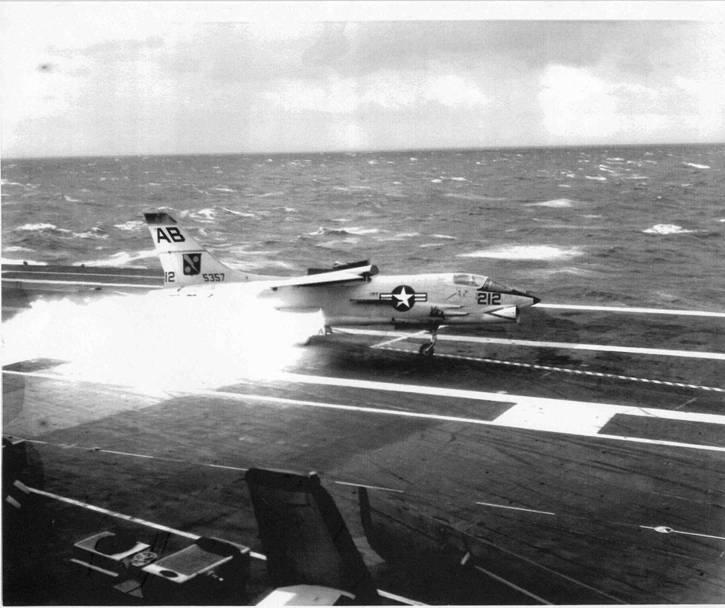
The movies showed a 5-foot diameter vapor donut for an instant just in front of the intake at the moment the engine flamed out. Terry cobbed the throttle and felt nothing so he “read the instructions”* as the nose passed over the end of the angle. *”Reading the instructions” is an euphemism for pulling the face curtain to fire the ejection . There are no instructions printed there, but if there were, one could read them…. if you read really fast. You can see him reaching for the curtain.
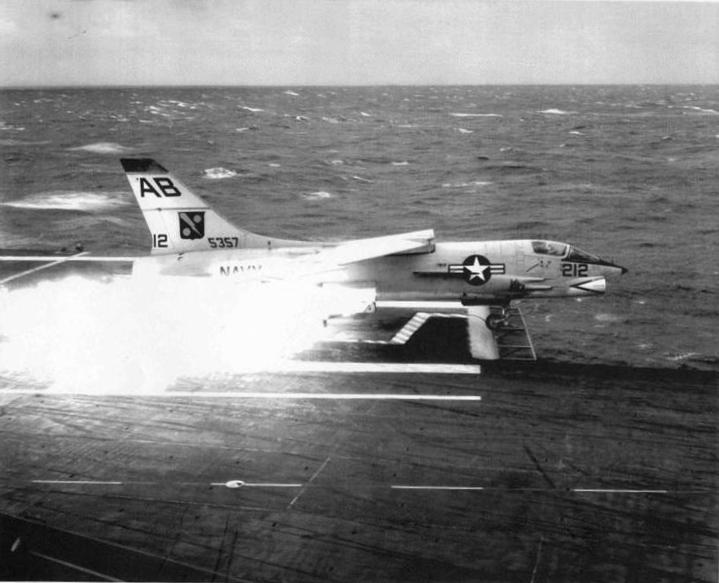
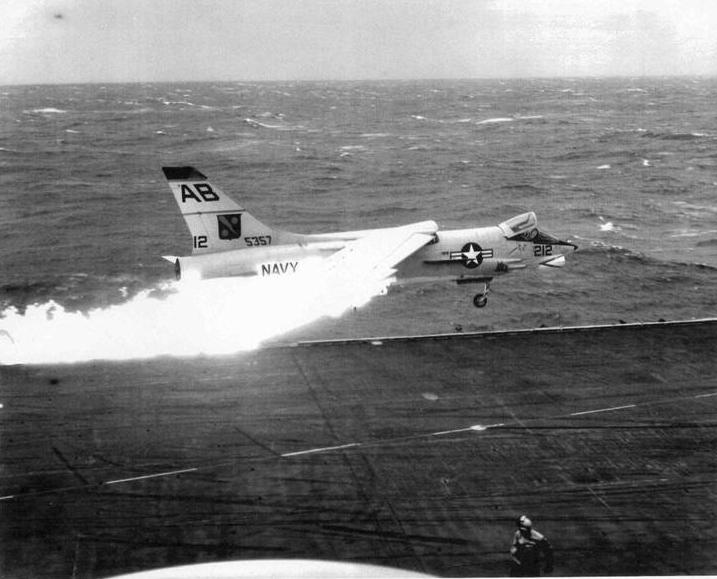
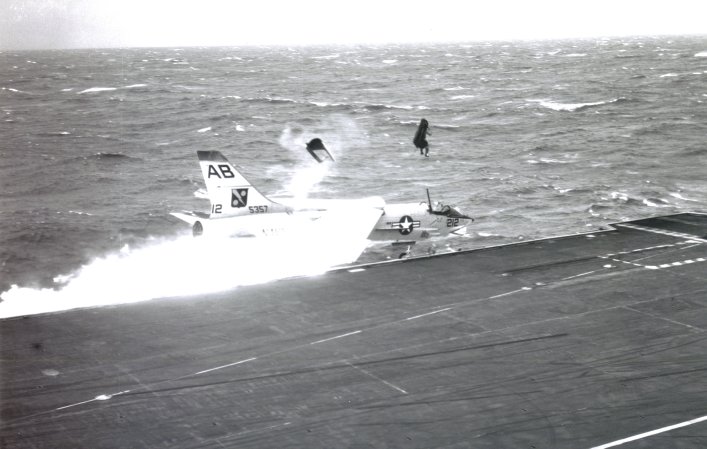
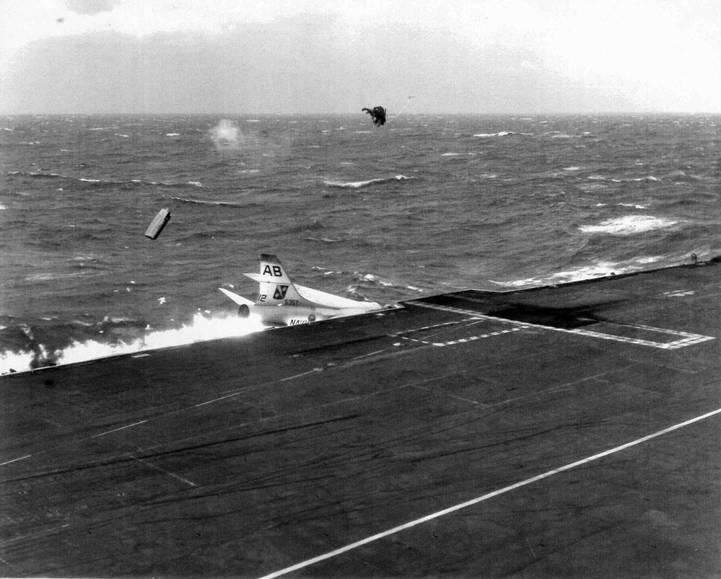
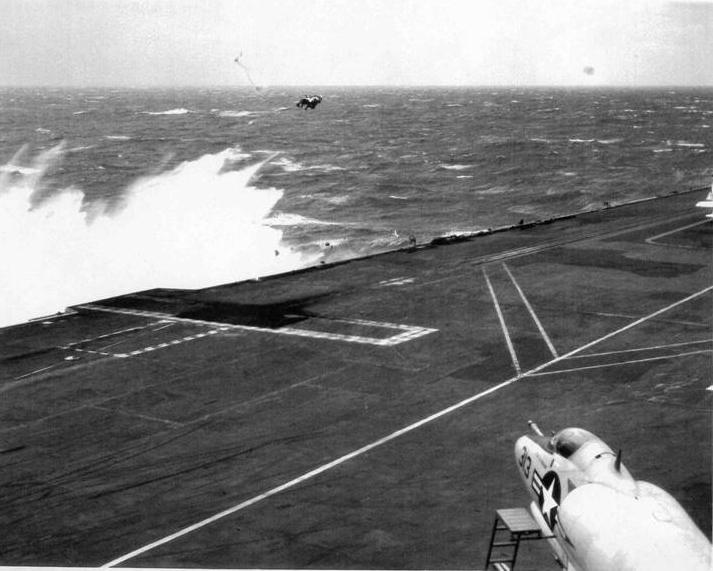

He got a small abrasion on his neck from his harness — and wet, but that was all!
[Story from – Jim Roberts, Swede Hedberg; Contributors – Troy Prince, Gary Schreffler; Image Source -US Navy ]
Additional info: ….as the aircraft left the angle deck of the USS Franklin D. Roosevelt (CVA-42) he initiated ejection of his Martin-Baker Mk. F-5 ejection seat. LT JG Kryway can be seen above the cockpit in the above view. This photo taken next in the sequence shows the seat has pitched forward (an effect of the catapult force being behind the center of gravity). The innermost catapult tube can be seen ‘behind’ the seat. In less than a second the drogue gun will fire to deploy the drogue parachutes which will then extract the main parachute. This ejection was unusually significant in part due to these clear photographs. After this ejection, the photographs were widely distributed among the pilot’s of the United States Navy. The sequence clearly demonstrated that the Martin-Baker seats were capable of saving a pilot in an off-the-deck ejection. This gave many pilots increased confidence in the system.
[Story from – EjectionSite.com]
Atlantic 09/29/64:
The USS Franklin D. Roosevelt (CVA-42) sustains damage to its Number 1 propeller during normal operations in the Mediterranean. The USS Independence (CVA-62) relieves the Roosevelt on Mediterranean duty and it returns to the U.S.to drydock.
Atlantic 10/12/65:
The USS Franklin D. Roosevelt (CVA-42) and the French merchantman Charles le Borgne collide off southern France. The carrier sustains little damage and continues its participation in”Lafayette IX,” a two-day bilateral U.S.-French exercise inthe western Mediterranean. The merchantman sustains minor structural damage and proceeds under its own power to Marseilles escorted by the USS Douglas H. Fox (DD-779).
Atlantic 02/23/73:
The USS Franklin D. Roosevelt (CVA-42) suffers minor damage from a brief fire in the hangar deck while the carrier is undergoing restricted availability in Mayport, Florida.
Mediterranean 01/11/77:
The USS Franklin D. Roosevelt (CV-42) collides with the Liberian freighter Oceanus as the Roosevelt proceeds south through the Strait of Messina. Both ships are able to proceed to port under their own power.





















